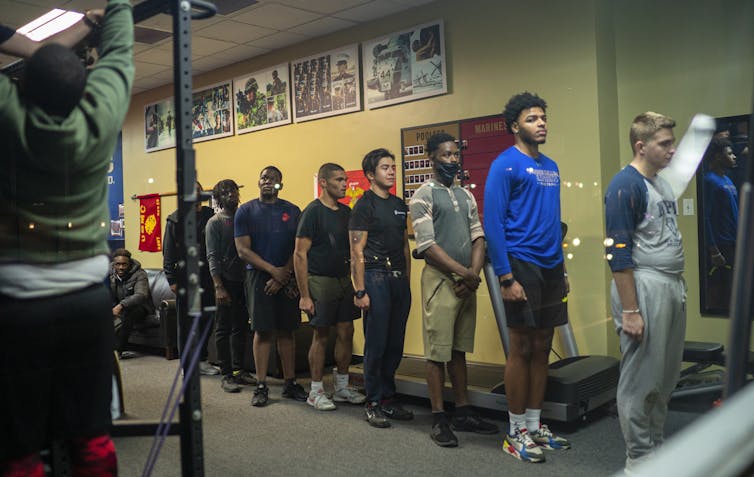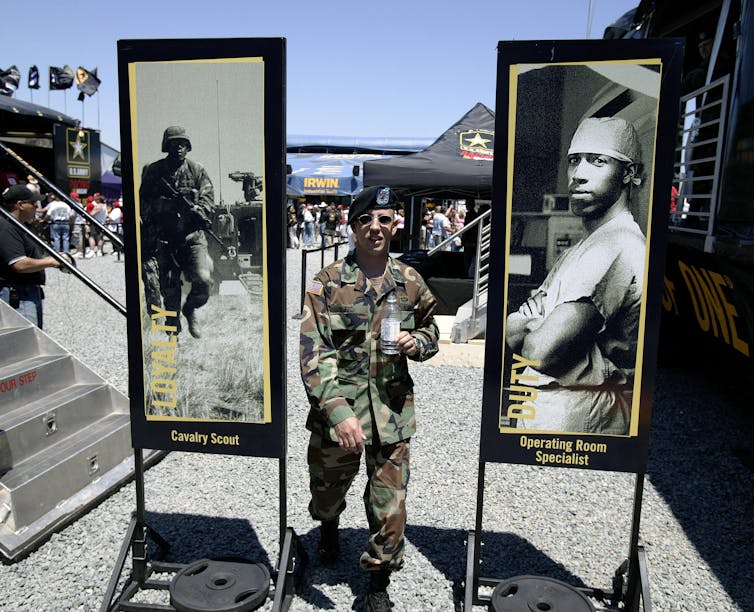The military’s diversity rises out of recruitment targets, not any ‘woke’ goals
- The US military’s diversity is not driven by “woke” goals or politics, but rather by recruitment targets and demographic needs.
- The military’s diversity has been a result of its all-volunteer force model, which relies on recruiting individuals from underrepresented groups to fill personnel needs.
- Women, Black Americans, and Latino service members have made up a disproportionate percentage of the military since the 1970s, with women increasing from 3% in 1973 to 17% in 2022.
- The military’s recruitment efforts have targeted “vulnerable target groups” based on propensity, including those facing financial struggles or limited opportunities outside of the military.
- Secretary of Defense Pete Hegseth and President Donald Trump’s criticism of military diversity is misguided, as it perpetuates the myth that diversity was enforced from outside the military rather than being a natural result of its needs and recruitment strategies.

Andrew Harnik/Pool via AP
Secretary of Defense Pete Hegseth and President Donald Trump addressed hundreds of military leaders at Marine Corps Base Quantico in Virginia in late September 2025.
Before the meeting, journalists speculated about which urgent issues might require such a costly and unusual gathering, to which the assembled military leaders had been summoned from across the globe.
Rather than a major shift in national security strategy, a loyalty oath or mass firing, Hegseth and Trump railed against what they see as the military’s primary enemy: diversity.
Hegseth claimed the Department of Defense became “the woke department” infected by “toxic political garbage” and the “insane fallacy that ‘our diversity is our strength.’”
Trump argued that the military “went, in a way, woke” and called for armed forces that would “not be politically correct.” Hegseth similarly called for a shift in military thinking about diversity saying, “No more identity months, DEI offices, dudes in dresses. … As I’ve said before and will say again, we are done with that shit.”
Having spent years studying the U.S. military and writing a book on diversity and military recruiting, the speeches made clear to me that Hegseth and Trump fundamentally misunderstand military diversity. Both men see it as a symptom of “woke” culture rather than as a long-standing practice driven by the very nature and history of the all-volunteer force.
Embracing diversity
During times of war and between 1948 and 1973, the U.S. military drafted enlistees to fill the ranks. After years of debate, the draft was ended and the U.S. established an all-volunteer force in 1973.
The demographic makeup of the military quickly changed as more Black Americans and women chose to join the military. In a 2007 study of representation in the military, scholars found that Black Americans had been overrepresented in the military for much of the span of the all-volunteer force. And the percentage of Latino service members more than doubled from the late 1980s to the 2000s.
Additionally, Latino service members made up 25% of new enlistees in 2022.
While women remain underrepresented in the military compared with the U.S. population, the shift to the all-volunteer force led to a steady increase in women’s military participation. Women made up 3% of military personnel in 1973 and 17% in 2022.
The military would not have been able to meet personnel needs and recruitment goals without the disproportionate representation of women, Black Americans, and Latino service members during this post-draft period.
The U.S. military embraced this diversity long before the influence of “woke” politics and diversity, equity and inclusion initiatives that Hegseth and Trump claim have undermined the institution.
That embracement has helped the military enlist between 128,000 and 190,000 new service members annually since the 1990s, even though some armed forces, especially the Army, have struggled to meet their recruiting goals in the past few years.

Robert Nickelsberg/Getty Images
Expanding the scope
To fully understand how the military became one of the most diverse American institutions, you need to go back to the foundations of the all-volunteer force.
The primary challenge the military faced in the implementation of the all-volunteer force was how to persuade young Americans to enlist. Large budgets were set aside for advertising, and military branches worked with advertisers to reach potential recruits.
One of the first steps advertisers took in the mid-1970s was to identify “vulnerable target groups.” These groups were targeted based on propensity – the likelihood that an individual would serve regardless of their desire to do so.
The likelihood of service increased when people felt they had little opportunity outside of the military – whether that meant financial struggles or an inability to afford higher education.
Based on ideas of recruit quality and the traits the military sees as best suited to success in the ranks, the military has mostly desired to recruit straight and white young men. But these people were more likely to have opportunities outside of the military. So, military leaders had to expand the scope of potential recruits to reach out to groups previously excluded – namely, Black Americans, other people of color and women.
When Hegseth talks about “fixing decades of decay” in a department gone “woke,” and when Trump argues that the military will now be “all based on merit,” they both fail to understand military diversity.
The military didn’t become diverse because it went “woke” or abandoned a merit-based system of promotions.
Military diversity resulted from the exploitative nature of military recruiting. In the all-volunteer force, the most easily persuaded recruits are those in most need of opportunities they can’t find in the civilian world. The very logic behind an all-volunteer force means that the military can’t fill their ranks with white men alone.

Robert Nickelsberg/Getty Images
Central casting
Hegseth and Trump, additionally, have framed their criticism of the military with an obsessive focus on looks.
Hegseth criticized the “bad look” of the current military, saying “it’s tiring to look out at combat formations, or really any formations, and see fat troops.” He also railed against “an era of unprofessional appearance” indicated by “beards, long hair and superficial individual expression.”
Trump has consistently talked about wanting military leaders to look like they are out of “central casting”, a phrase he uses almost exclusively to talk about white men.
The firings of Admiral Lisa Franchetti, the first woman to serve on the Joint Chiefs of Staff, and General CQ Brown Jr., the second Black Chair of the Joint Chiefs, appear to reflect this vision of the military in practice.
When Trump and Hegseth attack military diversity, they harm individuals who made the choice to serve. They also perpetuate the myth that military diversity was enforced from outside the military by liberal “woke” politics rather than born of necessity for the military’s very survival.
![]()
Jeremiah Favara does not work for, consult, own shares in or receive funding from any company or organization that would benefit from this article, and has disclosed no relevant affiliations beyond their academic appointment.
